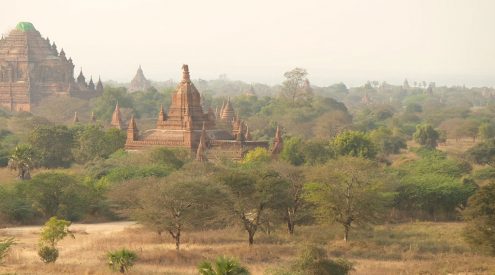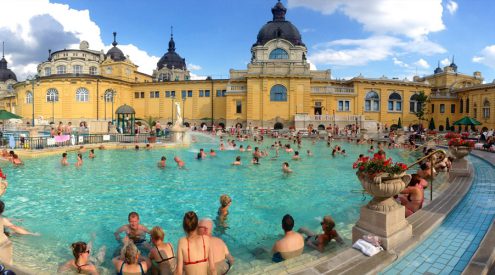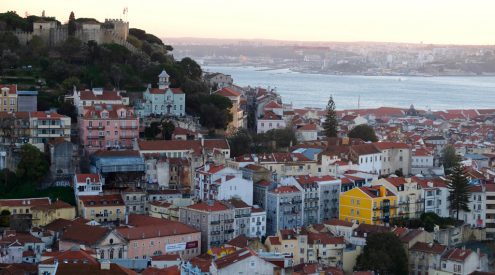I have always been intrigued by books set in India, particularly around the time of the Raj, and I could certainly identify with the Britishers that fled the oppressive heat of the south and headed for cooler climes in the foothills of the Himalayas.
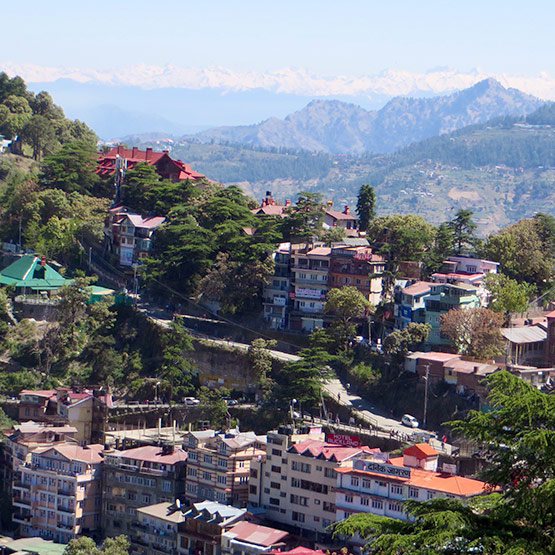
Looking out over Shimla, capital of the north Indian state of Himachal Pradesh, with the snow covered peaks of the Himalayas in the distance.
I cannot describe the relief of stepping off the toy train in Shimla and actually having to don a fleece top that had been superfluous baggage up to that point.
As pretty as Shimla was, perched high on the hillside, with magnificent views of snow covered peaks in the distance, it was too touristy for my liking and I was quite freaked out by the hordes of monkeys that roamed the streets, grabbing glasses off people’s faces or, in my case, snatching a sandwich out of my hand as I was lifting it to my mouth.

Surprisingly delicious Bhel Puri, made out of puffed rice, finely chopped vegetables and a tangy tamarind sauce, selling for 20 rupees (R4!)
Serendipity is a beautiful word and so far I had had many a serendipitous moment that had given my adventure direction. So it was when I met Javed. It is not uncommon to be accosted by touts trying to steer you to a particular hotel and offering you ‘special tours,’ but I had to give Javed full marks for perseverance, because he accompanied us the four kilometres up the hill to the main town (me huffing and puffing with the effort, but refusing to be helped with my wheelie bag), and then graciously bid us farewell after we made it to the YMCA and ignored all his overtures.
But I did have his card: Javed Dar – Great Escape Routes – Tours and Travels.
Turns out that according to our trusted Lonely Planet his was the only establishment in Shimla that offered WiFi facilities, so while I was catching up on my emails, Facebook and banking, I was listening with half an ear as Javed tried to entice my young friend Horacio with one of his many tours on offer. My ears pricked up at the mention of an eight-day jeep safari into the Spiti Valley ending in Manali. Spiti Valley? Somewhere in the recesses of my memory I seemed to have read or heard about this high altitude desert area, and spontaneity being my middle name, in a millisecond I had decided this is where I wanted to go.
Before I had left on my adventures my sister, the worrier, had sent me a video clip of a hair-raising bus ride in the Himalayas, and had warned me to avoid such escapades at all costs. My road trip into the Spiti Valley itself is worthy of a separate blog, but suffice to say I was on that road. And survived!
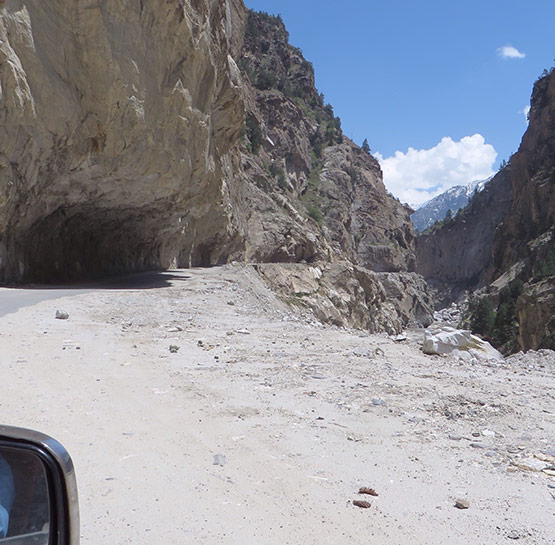
This picture does not do the appalling road conditions of the Tibet-Hindustan Highway any justice.
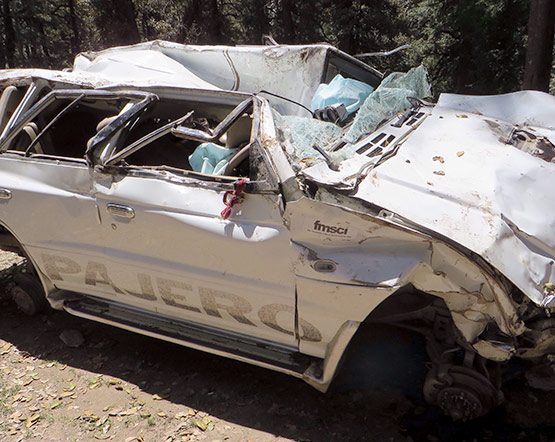
This car wreck which we came across on one of the hairpins on the Great Tibet-Hindustan Highway did not fill me with much confidence.
The Great Tibet-Hindustan Highway was built in the 1850s by the British to transport troops to the Tibetan border, which must have been an engineering feat in those days. According to Wikipedi it featured in the History Channel’s “IRT Deadliest Roads” TV series due to its poor maintenance and hazardous driving conditions. And I can attest to that! Not only were the roads appalling, at times our driver morphed into Ayrton Senna incarnate, hurtling along this winding single track road without barriers, 200 meters above the river bed, hooting and overtaking at impossible blind turns; it was insane and I was just praying that my Karma would allow me to survive this day.
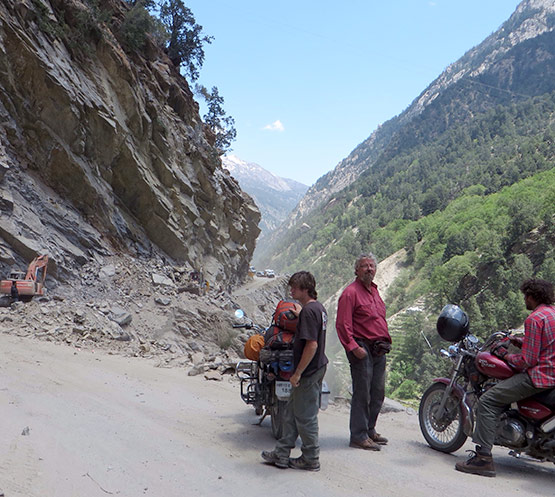
Patiently waiting for a rock-fall to be cleared with three adventurous fellow travellers on their Royal Enfields.
At times we were held up for hours by rockfalls that blocked the road which needed to be blasted and the rubble then pushed into the riverbed far below.
In Shimla I had vaguely listened to Javed describe a 10 day trip through Kashmir, starting off in the bustling town of Jammu, heading up to Srinagar with a few days on a houseboat on Dal Lake, followed by 4 days trekking in the Kashmir foothills of the Himalayas. Ever since reading the Kashmir Shawl by Rosie Thomas I had put Kashmir and Srinagar on my Bucket List and I had romantic visions of staying on one of the many exotic houseboats that had been so popular in the heyday of the Raj, when the British were not allowed to own land in India and hence resided these houseboats when escaping the sweltering summer months in the south.
Javed met me in Jammu (which I cannot recommend as a travel destination) from where he negotiated transport in a Mahindra ‘share-jeep.’ Only once the taxi driver managed to find 5 other passengers was our luggage thrown on the roof and we set off at a cracking pace.
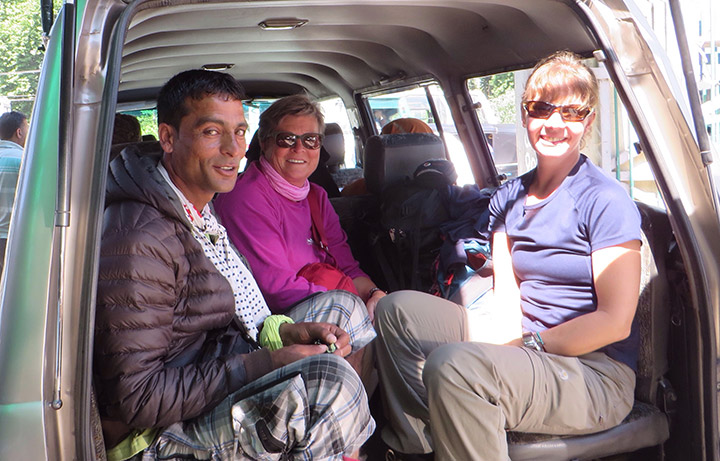
All aboard to Kashmir and Srinagar.
I am telling you, our South African taxi drivers are tame compared to these cowboys. Road rules do not apply in this country and I saw rupees exchange hands a few times when we were stopped and pulled over.
There are just over 1400 houseboats of varying quality on Dal Lake, and although we were not living 5 star, our “Dream Days” was very comfortable, moored alongside a little jetty from where we could sip Kashmir tea and watch life on the lake. Shikaras of every description criss-cross the lake, traders selling every item you can imagine, jewellery salesmen and photographers, and local children being taken to and from school. It was a veritable feast for the eyes.
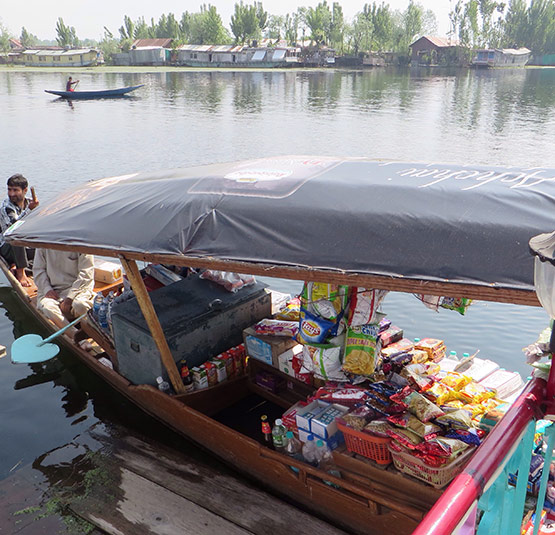
A trader peddling his wares from one of the thousands of shikaras that criss-cross Dal Lake in Kashmir’s Srinagar.
My final leg through India took me in another share-jeep across the Himalayas from Srinagar to the high altitude town of Leh in Ladakh. I had braced myself for a 14 hour daytime trip, but in India generally things do not go to plan. We had made it to the little skiing village of Sonamarg for breakfast and that is when our troubles began. We were hardly on the road again when all vehicles attempting the pass were herded off the road onto a huge parking lot. Nobody knew what the hold-up was and, with a few abortive re-starts that took us maybe a further 200 meters up the road, we eventually sat for 10 hours! It was hysterical when we finally got the go-ahead that the road had reopened. Everyone scrambled for their vehicles and it was a free-for-all trying to get pole position up the pass.
There were still a few hooligans trying to overtake, but in the end we crawled up the pass at snails’ pace and once darkness fell we could see hundreds of car lights ahead of and behind us. It had started raining and it was freezing cold, and the road conditions were beyond appalling. The road was cut through about 3 meters of snow and all along the way were trucks that could not make it any further. To try and squeeze past them needed a whole troupe of men to guide us, and again I saw myself plummeting down the mountain, this time in darkness.
We finally arrived in Dras, our halfway mark, at midnight when our driver threw in the towel. He was just too exhausted to continue, so all our luggage was transferred to another vehicle and off we set again. Music through my ear-phones and a good book on my Kindle saw me through the night and we eventually rolled into Leh at six in the morning.
And not a few days later I once again braved the Indian roads, this time over one of the highest drivable passes in the world at 5600 meters above sea level, the Khardung La Pass into the desolate and achingly beautiful Nubra Valley, which is part of the Silk Route into China.
It was my last adventure in this challenging, often frustrating, always exciting, colourful and vibrant country and in a nutshell: I survived India!









